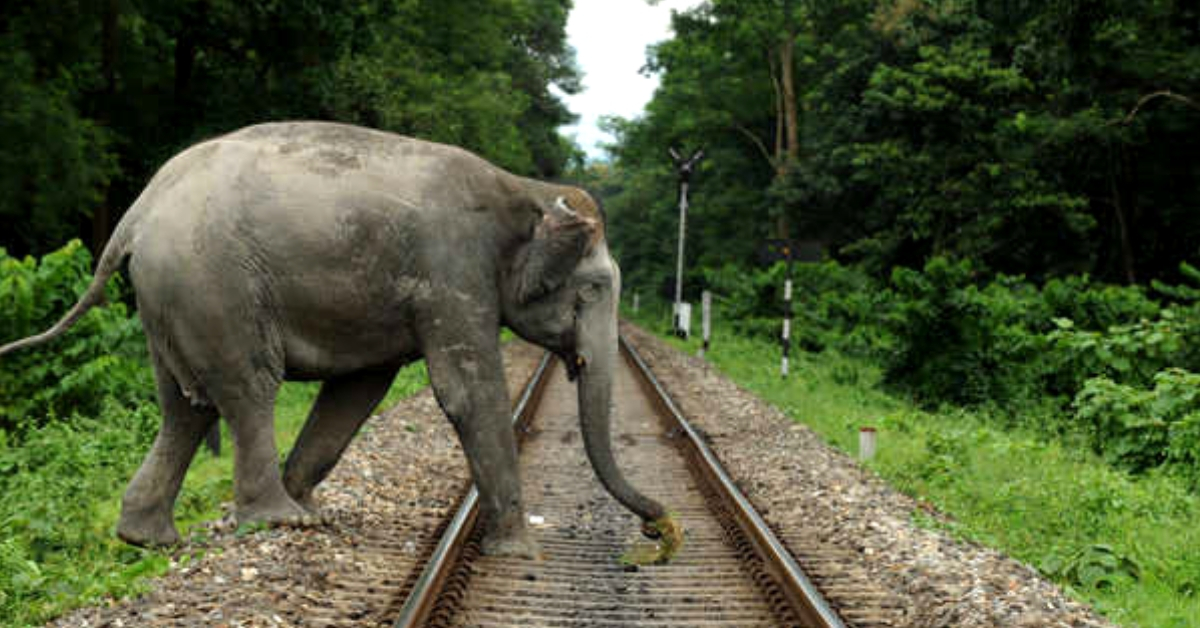Brilliant! IIT Delhi Finds Ingenious Solution to Stop Elephant Deaths Due to Train Accidents!
"When fitted to railway tracks, the sensors would track visuals, movement, sound, lights and other parameters before corroborating the inputs and feeding them into an automated algorithm."

Every once in a while, we read a story about an elephant who was run over by a train, the result of which was either a severe injury or in most cases, death.
In 2018 itself over 20 elephants lost their lives on railway tracks. Elephants move at a slow pace, and when a fast-moving train is coming towards them, they are not always able to get out of the way in time.
While we cannot stop elephants from crossing tracks, a device developed in IIT-Delhi could be the blessing we were all looking for.
Subrat Kar, a professor at IIT-Delhi, was working on a device to curb elephant deaths due to train accidents since 2008. In 2014, his research gained momentum when the Indian Railways extended financial support and provided him with a grant of Rs 30 lakhs.
Today, his device is ready and is delivering ‘satisfactory’ results.

Speaking to The Telegraph, Professor Kar said, “When fitted to railway tracks, the sensors would track visuals, movement, sound, lights and other parameters before corroborating the inputs and feeding them into an automated algorithm. The algorithm would then decide if an elephant or a herd was near the tracks. A message would be sent to the nearest station master and the driver of trains about to pass through the area.”
You may also like: Plan Bee: Check Out The Indian Railways Scheme Helping Elephants Cross Safely
The sensors will be fitted with vibration detectors, cameras and lasers. Together, these three will determine whether the passing animal is an elephant or not. Tigers, leopards and bears frequently cross tracks in the jungle as well. However, their stealth and agility help them get out of the way, which is not always possible in the case of an elephant.
Speaking to the New Indian Express, Professor Kar said, “We will install sensors at sensitive spots, and not everywhere. There are known paths along which the elephants move, so we install sensors on these paths. The sensors detect them through body rays, cameras and vibration.
Then we convey the information to the nearest station, and from there we convey the information to the train driver.”

A warning light fitted in the trains will then signal the driver to slow down about three kilometres from where the animals are estimated to be crossing. They will get about three to four minutes to slow down or stop the train.
The device looks promising since it does not restrict the animals, who have the freedom to move around the forest as they please, but sends signals to the train to halt to allow them to pass. It has passed the necessary tests and will soon be installed in places that have been earmarked as elephant corridors.
You may also like: Biodegradable Paper from Paddy Straw? This Project By IIT Delhi Is Doing It!
Speaking about when the device will be installed, Professor Kar informed IANS, “The sensors are yet to be installed. This was to be tested in the monsoon season. Since this monsoon has passed, we are waiting for the 2019 season. Our system is functional. We have tested in a similar setting but not at the site. We have earmarked the Rajaji National Park as the test deployment site. It is the ideal place, kind of a controlled environment and good for experiments. It’s where trains are known to travel at the correct speed.”
(Edited by Gayatri Mishra)
Like this story? Or have something to share?
Write to us: [email protected]
Connect with us on Facebook and Twitter.
If you found our stories insightful, informative, or even just enjoyable, we invite you to consider making a voluntary payment to support the work we do at The Better India. Your contribution helps us continue producing quality content that educates, inspires, and drives positive change.
Choose one of the payment options below for your contribution-
By paying for the stories you value, you directly contribute to sustaining our efforts focused on making a difference in the world. Together, let’s ensure that impactful stories continue to be told and shared, enriching lives and communities alike.
Thank you for your support. Here are some frequently asked questions you might find helpful to know why you are contributing?


This story made me
-
97
-
121
-
89
-
167













